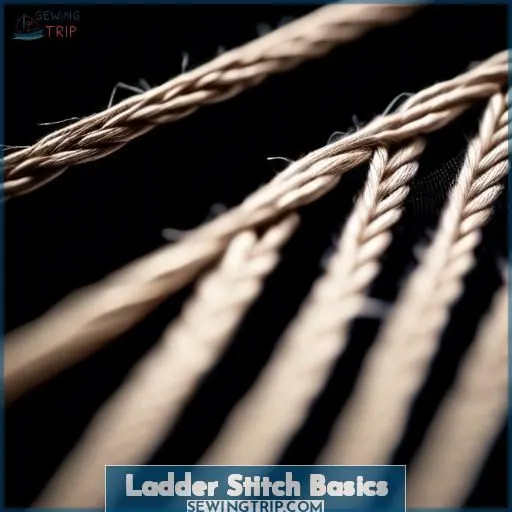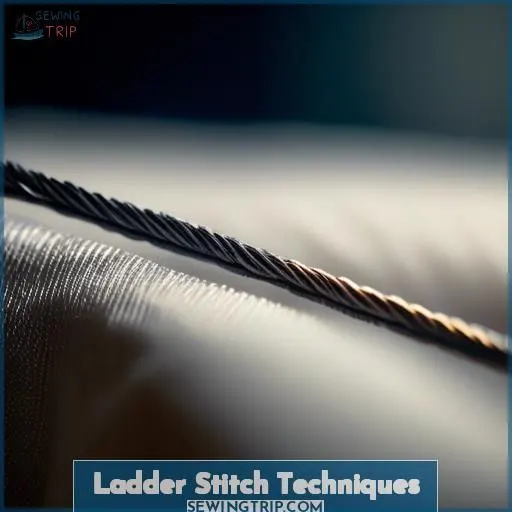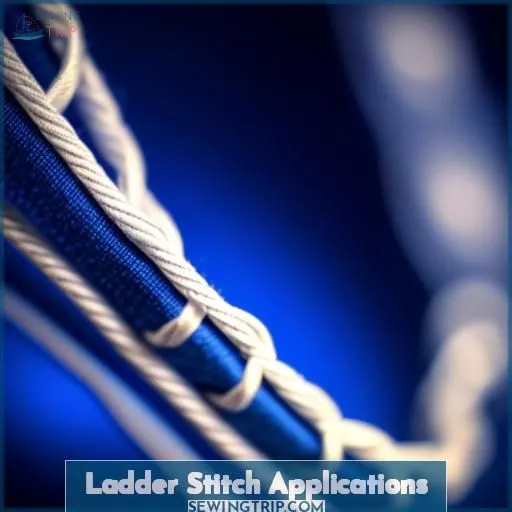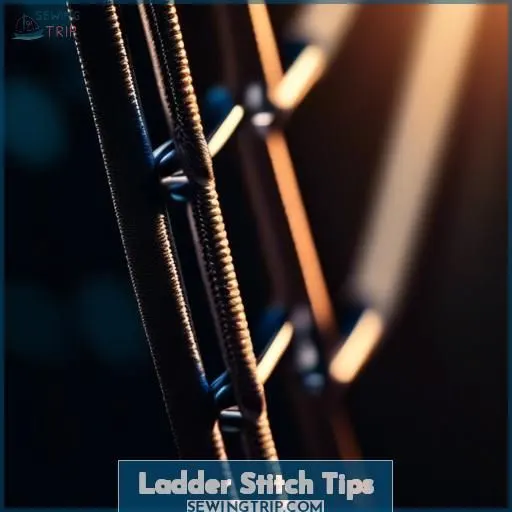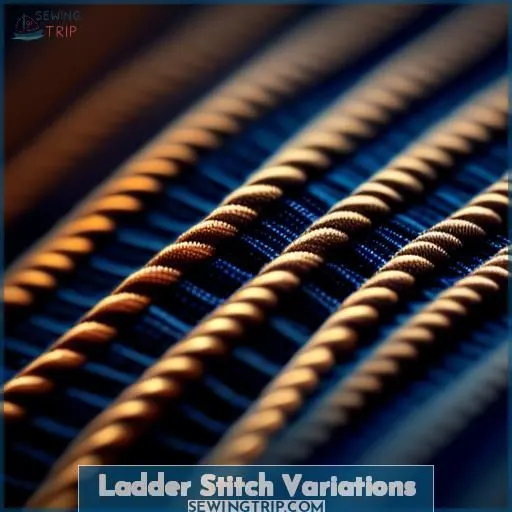This site is supported by our readers. We may earn a commission, at no cost to you, if you purchase through links.
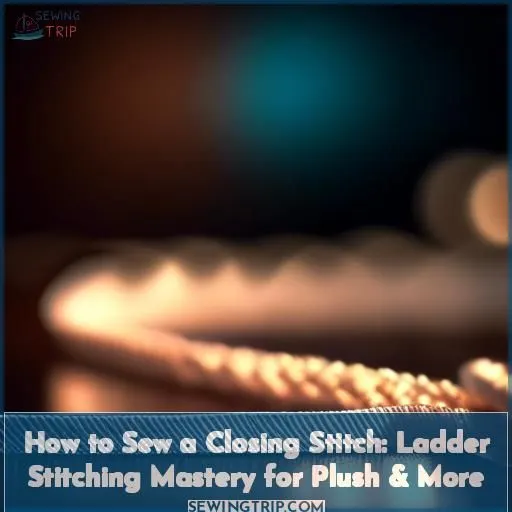
To sew a closing stitch, you’ll master the ladder stitch – an ingenious hand-sewing technique delivering a virtually invisible, robust seam.
First, thread a sharp needle with strong thread matching your fabric. Knot the end, and push the needle up through the folded seam allowance.
Create the ladder stitch by picking up parallel stitches of equal length. Maintain even tension, hiding knots within the fold. For extra strength, use two thread strands.
Explore pressing creases as guides, tucking seam allowances under for a tidy look.
Discover how this versatile stitch lets you craft heart pillows, plush pumpkins, and more.
Table Of Contents
Key Takeaways
- Choose the right needle and thread for the fabric you’re using.
- Thread the needle and knot the end before starting.
- Create the ladder stitch by picking up parallel stitches of equal length and maintaining even tension.
- Use two thread strands for extra strength and hide knots within the fold.
How to Sew a Closing Stitch?
To sew a closing stitch, the ladder stitch technique is commonly used, involving alternating small stitches across the fabric’s fold to invisibly close an opening. This method is ideal for finishing plush toys or pillows, ensuring a seamless look without visible thread.
Ladder Stitch Basics
You’ll start by threading your needle and knotting the thread end. Next, you’ll push the needle up through the folded seam allowance to make the starting stitch, being sure to leave a tail on the underside.
Threading the Needle
Threading a needle is a vital first step in conquering the ladder stitch, a popular tactic for making imperceptible seams in plush toys, dolls, and other projects. Here are some essential tips to help you get going:
- Choose the right needle: Select a sharp, skinny needle that matches the fabric and thread you’ll be utilizing. A dull or thick needle can make the process more arduous and less accurate.
- Store your needles properly: Keep your needles organized and easily reachable by storing them in a needle case or a designated area.
- Threading tricks: There are several methods to thread a needle, such as using your mouth, water, or even a self-threading needle. Experiment with different techniques to find what works best for you.
- Sharpen your needle: Regularly sharpen your needle to guarantee it glides smoothly through the fabric.
- Dispose of used needles safely: Dispose of used needles in a puncture-proof container to avoid injury.
Once you’ve threaded your needle, you’re ready to move on to the next step: knotting the thread. This will help secure your stitch and guarantee a strong, imperceptible seam.
Knotting the Thread
Tying the thread is an essential step in the ladder stitch process. The knot serves as the foundation for the stitch, guaranteeing a secure connection between the two sides of the fabric. There are different knot techniques you can use, depending on the type of thread and the specific project requirements.
One alternative knotting method is to use a decorative knot, which can add a unique touch to your stitching. For example, when sewing plush patchwork pumpkins, a decorative knot can enhance the overall look of the project.
The placement of the knot is also vital for the success of the ladder stitch. It should be positioned close to the edge of the fabric to ensure that the stitches are evenly spaced and the seam is invisible.
To secure the knot, you can use a ladder stitch technique. This involves inserting your needle into the seam next to the knot, pushing it through the item you’re sewing, and coming out in the middle somewhere. Then, pull the thread tight and trim the end.
In addition to securing the knot, you may also need to strengthen the stitch by repeating the process a few times to ensure that the seam is strong and durable. This is particularly important when working with plushies or other projects that require a high level of strength and durability.
Starting the Stitch
To start the ladder stitch, you’ll need to thread your needle and tie a knot at the end of your thread.
Once your needle is threaded, you can begin stitching by pushing the needle up through the seam from the back to the front, then down and up through the opposite seam crease.
Continue this process until you reach the end of the opening.
Remember to keep your stitches small and close together for a tidy seam.
Creating the Ladder Stitch
Creating the ladder stitch is an essential step in hand stitching, especially when aiming for an invisible seam on plush toys, bunny softies, heart pocket pillows, or even disappearing quilt blocks.
To create the ladder stitch, you’ll need a needle, thread, and a needle threader.
Start by ironing the folds of the opening flat and hiding the knot inside the fold.
Then, bring the needle out through the folded edge and push it into the opposite fold directly across.
Slide the needle along the opposite fold and push it out again.
Continue this back-and-forth-and-slide pattern until the end of the opening.
The tiny stitches on the outside will show, while the inside stitches will be hidden, resulting in an invisible seam.
Finishing the Stitch
Finishing the Ladder Stitch:
- Finish your stitching by bringing the needle up from where it came out and inserting it into the opposite fold.
- Continue the back-and-forth-and-slide pattern until the end of the opening.
- The tiny stitches show, while the inside stitches are hidden, creating an invisible seam.
- To secure the end, pick up a tiny section of the seam opposite where the thread emerges and pass the needle and thread through the loop. Tighten and form a knot, then repeat for reinforcement. Snip the threads.
Securing the End
To guarantee the end of your ladder stitch, start by picking up a tiny section of seam opposite where the thread emerges. Pass the needle and thread through the loop, tighten, and form a knot. Repeat this process for reinforcement, then snip the threads. This guarantees your closing stitch remains invisible and your plush project is secure.
Ladder Stitch Techniques
You can strengthen your ladder stitches by using two strands of thread instead of one. Utilize the pressed creases of the folded seam allowances as guides to guarantee your stitches are perfectly aligned and evenly spaced.
Stitching With Two Strands of Thread
Regarding hand stitching, particularly for plush and st■ toys, employing two strands of thread can considerably improve the firmness, longevity, and inconspicuousness of the stitch. Here’s the procedure:
- Thread the Needle: Commence by threading your needle with two strands of thread. Ensure the threads are doubled, with the twists cohering in the same direction. This is known as the No-Knot Invisible Thread Start technique, which is prevalent among embroiderers.
- Stitch Length: Modify the stitch length to correspond with your project. For plush and st■ toys, a shorter stitch length will facilitate the fabric lying flat and obviate puckering.
- Stitching: As you stitch, sustain uniform tension and maintain the stitches proximate. This will facilitate the thread harmonizing with the fabric and engendering a more inconspicuous appearance.
- Thread Color: Select a thread color that corresponds with or is modestly darker than the fabric. This will facilitate the stitches harmonizing and render the project more professional in appearance.
- Thread Thickness: Employ a slender thread that isn’t thicker than the fabric. Thicker threads may manifest through the fabric and diminish the overall appearance of the project.
- Thread Sheen: Opt for a thread with a dull finish rather than a lustrous one. Lustrous threads may reflect light and draw attention to the stitches, rendering them more conspicuous.
Using Creases as Guides
Using creases as guides is a vital aspect of mastering ladder stitching for closing dolls and plushies.
Creases act as inherent markers for stitching uniformly, assuring precision and preventing puckering.
By adhering to these creases, you can achieve a neat, smooth seam that integrates seamlessly with the fabric.
This technique is particularly advantageous when working with the Ladder Stitch, a favored choice for invisible seams.
As you acquire the skill of using creases as guides, you’ll observe that your stitching becomes more precise and your projects more refined.
Pulling Thread Taut
To craft a robust, uniform ladder stitch, it’s essential to maintain tension in the thread. Here are four techniques to achieve the desired firmness:
- Tighten stitch: Draw the thread firmly to secure each stitch, guaranteeing a stable connection between the fabric layers.
- Thread tension: Monitor the thread tension to sustain a consistent stitch length and aesthetic.
- Even stitching: Strive for uniformity in stitching on both sides of the seam, enhancing its strength and overall appearance.
- Chain stitch: Practice with a chain stitch to develop a sense of the proper tension, then apply this technique to your ladder stitch for superior results.
Hiding Knots
Hiding knots is a crucial part of the ladder stitch process. The knot should be concealed within the fold of the fabric to guarantee a clean and invisible seam. There are several techniques to achieve this:
- Knot Hiding Techniques: Insert the needle into the seam next to the knot and push it through the item you’re sewing. Come out in the middle somewhere and pull the thread tight. This will create a knot that’s hidden within the fold of the fabric.
- Concealed Knot Placement: Relocate the knot to a side seam where it’s less noticeable.
- Knot Size and Visibility: Make sure the knot is small enough to be concealed within the fold of the fabric.
- Knot Reinforcement Methods: Repeat the process to secure the knot, ensuring it’s tightly tied and hidden.
- Knot Appearance in Different Fabrics: Use a thread that closely matches the color of your fabric to make the stitch even more invisible.
Incorporating these techniques into your ladder stitch process will help you achieve a clean and professional finish for your projects.
Reinforcing the Stitch
To reinforce the ladder stitch, consider these three options:
- Thread strength: Use a strong thread, such as hand quilting thread, for added strength and durability.
- Knot placement: Place the knot at the end of the opening, and then tie a knot at the end of the thread to secure it.
- Stitch tension: Make certain the thread tension is tight enough to close the gap between the two pieces of fabric, but not so tight that the fabric bunches.
Ladder Stitch Applications
You can showcase your ladder stitch skills by making heart pocket pillows – perfect for Valentine’s Day or as a whimsical home accent. Sew plush patchwork pumpkins using the ladder stitch to join fabric pieces, stuff, and add decorative touches, creating festive fall decor.
Making Heart Pocket Pillows
To create a heart pocket pillow, start by cutting two heart shapes from plush fabric.
Sew the sides together using a ladder stitch, leaving an opening for stuffing.
Stuff the heart with polyfill, then close the opening with a ladder stitch.
For a fun twist, add a pocket by sewing a separate piece of fabric to the heart’s opening.
Use various sewing techniques to embellish your heart cushion, such as adding plush animals or other decorative elements.
With practice, you’ll master the art of creating unique and adorable heart pocket pillows.
Sewing Plush Patchwork Pumpkins
After mastering heart pocket pillows, plunge into sewing plush patchwork pumpkins.
This project allows you to experiment with color combinations and pumpkin patterns, guaranteeing that each creation is distinctively yours.
Refine your stuffing methods to bestow your pumpkins with a lifelike form.
Incorporate embellishments for a personalized flair.
Keep in mind, the appropriate stitch can transform fabric remnants into a masterpiece of patchwork.
Other Project Ideas
The ladder stitch is a versatile technique that can be used in a variety of projects, not just for closing dolls and plushies. Here are some alternative ladder stitch methods and projects suitable for ladder stitch:
- Blind Joining Stitch: This is a variation of the ladder stitch that’s used to join two fabric edges very finely and inconspicuously. It’s often used when sewing tucks in fabric or for mending clothes.
- Herringbone Ladder Stitch: This stitch is a type of weaving stitch that’s used to create a beautiful border or filling stitch. It can be used in various projects, such as embroidery or quilting.
- Invisible Ladder Stitch: This stitch is used for joining two fabric edges very finely and inconspicuously, making it popular for sewing st■ toys, pillows, or lined hems.
- Open Chain Stitch: This stitch is a variation of the chain stitch and is also known as the Ladder Stitch, Roman Chain Stitch, or Square Chain Stitch. It’s often used for borders and is a favorite stitch for embroidery.
- Sewing Jackets: The ladder stitch is regularly used when sewing jackets to finish edges, especially for closing hems.
Remember to choose the right ladder stitch for your project and to use strong thread for added strength. Always conceal the turning opening and create small, close stitches for a more invisible seam. For more information on ladder stitch techniques and resources, consider reading Becky Jorgensen’s articles and tutorials on her website or social media platforms.
Ladder Stitch Tips
You’ll want to use a thimble to protect your finger while pushing the needle through thick fabric. Iron the opening flat before starting to conceal the turning gap, then tuck the seam allowance under for a crisp, clean finish.
Using a Thimble
A thimble can be your closest companion when hand stitching.
It provides finger protection and comfort, particularly when working with sharp needles or thick threads.
Thimbles come in a spectrum of types, materials, and sizes.
Select one that aligns with your preferences and project.
For example, leather thimbles offer durability, while silicone thimbles provide a snug fit.
Consistently verify that your thimble is the correct size for your finger to prevent discomfort or injury.
Ironing the Opening
To create a polished finish for your project, ironing the opening before sewing is of utmost importance. This step guarantees that the fabric is smooth and flat, facilitating the alignment of edges and uniform stitching. Here’s how to achieve this:
- Press the seam firmly to flatten it. This step is vital as it helps you envision the stitching lines and ensures that the edges are aligned correctly.
- Smooth the edges of the opening along the seam allowance, ensuring they’re straight and aligned with the previous seams.
- If the fabric resists pressing or the seam allowance remains soft, mark the seam allowance with a marking pen or chalk. This will guide the stitches along the marked lines, ensuring consistent and parallel stitching.
Concealing the Turning Opening
To hide the turning opening with a ladder stitch, start by ironing the opening flat to ensure it’s smooth and even.
Then, when stitching, hide the knot inside the fold and use the creases of the folded seams as guides for your stitches. This will help make the seam less noticeable.
Once you’ve finished stitching, pick up a tiny section of the seam opposite where the thread comes out and pass the needle and thread through the loop. Tighten and make a knot, then do it again to make it stronger before cutting the threads.
Creating Small, Close Stitches
Producing tiny, snug stitches is essential for a pristine outcome in your soft projects. To attain this, employ tweezers to grasp the needle and threader with precision. While stitching, maintain tension on your needle and thread to guarantee uniform stitching. This will aid in making your ladder stitch look tight and nearly unnoticeable.
Tucking the Seam Allowance Under
Folding the seam allowance under is a critical step for creating a tidy and inconspicuous seam. Here’s how to do it:
- Fold the seam allowance at the opening.
- Push the needle up through one folded seam and pull the thread through.
- Push the needle down and up through the opposite seam crease to form the stitch.
- Continue until reaching the end of the opening.
- Pull the thread to tighten and hide the stitches between the seam sides.
Remember to use sturdy thread, like hand quilting thread, and consider stitching with two strands for added strength. Use creases as guides and pull the thread tight for even stitching. Hide knots inside folds and reinforce the stitch for added security.
Ladder Stitch Variations
While the ladder stitch is a go-to technique for invisibly closing openings, you can also explore chain stitch, whip stitch, sampler stitches, and other stitch variations. Each offers unique qualities for finishing edges, appliquéing, or adding decorative touches – experiment to find your favorites for different sewing projects.
Chain Stitch
The chain stitch, a variation of the ladder stitch, is a versatile embroidery technique that forms a chain-like pattern. It’s often used for outlines, fillings, and motifs in various sewing and embroidery projects. The basic chain stitch is easy to learn and can be worked in any direction, making it a popular choice for both beginners and experienced stitchers.
Chain stitch uses a single continuous thread that loops back on itself, creating a roping effect. This stitch is traditionally used for hemming jeans and can be used to mimic a drawing effect on fabric. There are numerous variations of the chain stitch, such as the double chain stitch, which uses two threads and is rarely used in modern machines except for ornamental purposes.
Chain stitch can be used for decorative purposes in plush toys and dolls, adding texture and visual interest to the fabric. It can also be combined with other stitches, such as the twisted chain stitch, to create more complex designs.
To master the chain stitch, start by threading your needle and knotting the thread. Begin stitching by bringing the needle up through the fabric and then down into the same hole, looping the thread under the needle and pulling it through. Continue this process, looping the thread under the needle and pulling it through, to create a chain-like pattern.
Chain stitch is an ancient technique, with the earliest archaeological evidence dating back to 1100 BC in China. It has been used in various cultures, including Kashmiri numdahs, Iranian Resht work, Central Asian suzani, Hungarian Kalotaszeg written embroidery, and Jacobean embroidery.
Whip Stitch
In the realm of hand stitching, the whip stitch emerges as a widely employed technique for shaping a seam or uniting two fabric sections. Its simplicity lies in its method of repeatedly passing the needle in and out of the fabric’s edges. Although not the most inconspicuous stitch, it can still forge a tidy seam, particularly when dealing with plush toys or malleable materials.
To execute a whip stitch, procure a needle, thread, and an optional thimble. Commence by securing a knot at the thread’s extremity and guiding the needle through the fabric between the intended joined pieces. Initiate the first stitch by directing the needle to the opposite fabric side and returning it through the initial piece, approximately 1/4 inch from the starting point. Persist with this procedure, consistently bringing the needle upwards through the second piece and downwards through the first, until the seam’s conclusion is reached.
One virtue of the whip stitch lies in its capacity to create a robust bound seam, proving advantageous for plush toys or objects requiring enhanced durability. However, its spacing or alignment may not attain the uniformity of other stitches, and unevenness can occasionally manifest towards the work’s terminus if stitches are spaced too widely.
Despite these shortcomings, the whip stitch endures as a popular selection for numerous sewing endeavors due to its straightforwardness and efficacy in preventing fabric fraying. If a more subtle stitch is desired, consider the ladder stitch, commonly utilized for bindings, linings, and appliqué.
Sampler Stitches
Ladder stitch variations, such as sampler stitch patterns, can add a touch of creativity to your hand stitching.
These unique closing stitches aren’t just for plush toys; they can also be used in decorative hand stitching projects.
By experimenting with different stitch patterns, you can enhance the appearance of your work and showcase your mastery of ladder stitching.
Don’t limit yourself to the basics – explore the realm of creative embroidery stitches and let your imagination soar.
Other Stitches
As far as variations of ladder stitch are concerned, there’s a vast array of possibilities beyond the fundamentals.
For a decorative twist, attempt a contrasting thread shade for your ladder stitch.
If you seek a concealed stitch placement, consider using a whip stitch for a more inconspicuous finish.
For adornments, experiment with sampler stitches or perhaps even other stitches brought up in the comments.
The key is to explore and identify the perfect stitch for your project, ensuring an exceptional finish.
Frequently Asked Questions (FAQs)
What is the difference between ladder stitch and whip stitch?
Ladder stitch is your ninja move for invisible seams, slipping between fabric folds like a ghost. Whip stitch, on the other hand, is the sturdy, visible sidekick, wrapping around edges but might pucker a bit.
Can I use a ladder stitch for visible seams?
Yes, you can employ a ladder stitch for apparent seams. The ladder stitch is conventionally used to create an imperceptible seam, but it can also be utilized to sew visible seams. The key is to ensure the stitches are uniform and closely spaced, which will help minimize the visibility of the stitching. Additionally, you can use a thread color that harmonizes with the fabric to further diminish the visibility of the stitches.
If you seek a stitch that’s utterly imperceptible, you may wish to consider employing an alternative stitch, such as a whip stitch, which is more suited for imperceptible seams.
How do I prepare for ladder stitching?
To prep for ladder stitching, thread your needle, tie a knot, and press the seam allowance at the opening. This smooth start sets you up for a seamless finish, pun intended.
What materials do I need for ladder stitching?
To sew a closing stitch, you’ll need a few materials: a needle, thread, pins, scissors, and an iron (optional) with an ironing board (optional) . The needle should be threaded with a double layer of thread for extra strength. For the ladder stitch, you’ll also need a project that requires an invisible seam, such as st■ toys, pillows, or lined hems.
How do I finish a ladder stitch?
To finish a ladder stitch, you need to pull the thread taut and secure it within the fold of the hem, rather than showing on the outside edge of the fabric. Here’s how to do it:
- Pull the thread taut: When you reach the end of your open section, the thread should close your stitch and hide the ladder stitch you just made within the fold of the hem.
- Pinch the thread and fabric: Make sure that the folds are perfectly matched at the point where the machine stitch stopped. Think of the two folds as the right and the left side of the ladder that makes the stitch.
- Insert your needle through the right side of the fold: It’s important to always insert the needle through the inside edge of the fabric.
- Make a knot: Once you’ve reached the end of the opening, tie a knot at the end of the thread by bringing your needle through the inside stitches and looping it. Thread your needle through the loop and pull it taut.
- Repeat several times: To secure the knot, repeat this process several times.
- Cut the end of the thread: Trim the end of the thread close to the fabric.
- Tuck the ends into the fold: Finally, tuck the ends of the thread into the fold to hide them.
Conclusion
Mastering the seamless ladder stitch opens a world of possibilities, allowing you to breathe life into cuddly creations like heart pillows and pumpkin pals. With practiced hands and patient stitches, you’ll securely sew a closing stitch, leaving nary a trace of your artful technique. Embrace this versatile stitch, and let your imagination soar as you craft cherished keepsakes.

